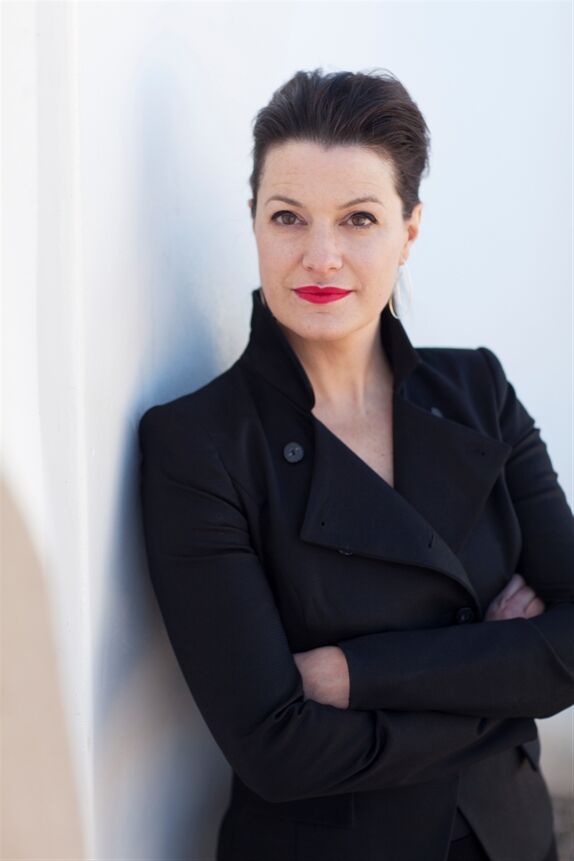
Irene Hofmann SITE Santa Fe Lecture

by Jac Kuntz (MA 2016)
Irene Hofmann (BFA 1993) returned to SAIC as the Distinguished Alumni Lecturer for the Visiting Artists Program fall 2014 series. Hofmann is the Director and Chief Curator at SITE Santa Fe, New Mexico, a nonprofit art center founded to organize the Santa Fe International Biennial of Contemporary Art. Under Hofmann's guidance, it has proliferated into an exhibition series that is vitally relevant to the regions of the North, Central, and South Americas—unprecedented as a cultural exploration in the grander scope of the international contemporary art scene.
Hofmann opened her lecture with a tribute to the people and experiences that molded her curatorial practice. She mentioned her research on Mary Reynolds, an influential member and documenter of the Dada and Surrealist movements, and her exposure to creative direction by Mary Tucker, the founder of the New Museum. She discussed her career shifts and pathways, drawing from her experiences as an undergrad at SAIC and internship at the Museum of Contemporary Art, Chicago (MCA).
Hofmann took up the position at SITE Santa Fe during a critical period of development in which it was necessary to re-evaluate the role of a biennial and seek new directions. Santa Fe was one of the earliest art institutions to hold an international biennale in the United States. It not only put the city on the map of the contemporary art world but became a seed for a vibrant local art scene. The idea for the new direction of SITE Santa Fe came to Hofmann during a drive along Highway 25, past the exit for the Pan American Highway. She thought about Santa Fe’s central location on this highway that stretches from Nunavut, Alaska, to Tierra del Fuego at the tip of South America. She began asking questions about the structure of contemporary art. Contemporary art has always functioned latitudinally, attending to the artists and scenes from East to West. What if, she thought, it were distributed along an axis that stretched north to south? She decided to fashion an exhibition that would speak of the tradition, culture, histories, and issues of the Americas, specifically areas that weren’t often represented in the global scene. She was fascinated in “Santa Fe’s connectivity to the Americas” and how thousands of miles of underrepresented regions yielded a population that represents thousands of years of history from Mexican, Spanish, Native American, and early settler cultures.
For this mission, to remodel the event, Hofmann called together a group of North and South American curators, to convene in her home and discuss the potential direction of the Santa Fe Biennial. The panel decided that it was essential that biennials be more meaningful to the community, that the role of the curator should be reassessed, and that an institutional structure should be implemented that could be continually refreshed. They also discussed the understanding of maps, cultural terminology, regional audience, and sensitivities to history that must be understood by artists and curators alike. SITE Lines: A New Perspective on art in the Americas will implement this model in a series of exhibitions that relate to the regions of the Americas.Unsettled Landscapes, which opened July 2014 and will continue through January 2015, is the first of the series.
Untitled Landscapes was organized by two Santa Fe curators (including Hofmann) in collaboration with curators from Mexico City and Albuquerque. An advisory team was also put together, drawing in curators from Canada, the Caribbean, and South America. The show exhibits work from 45 artists from 15 countries. Some projects will even span the duration of the series (2014, 2016, 2018) in an ongoing, in-depth exploration of the region. According to Hofmann, the show will examine and portray the land in a way that “looks at the urgencies, political conditions, and historical narratives that inform the artists.” Three vital themes are at the core of Untitled Landscapes: Landscape Territory, and Trade. As Hofmann explains, “Landscape is the image of the land; landscape is not neutral. It is about the travel across land. Territory looks at borders, resources, and land use. Trade looks at the movements of goods and people, and looks at the exchange and economies of the land.”
The lecture concluded with a look at a few project highlights that comprise this pilot exhibition series. Miller Lagos’s Great Tree installation was inspired by a Amazonian creation myth and was constructed form four tons of recycled newspaper, collected form the local community. Iñigo Manglano-Ovalle covered controversies of water rights in the American Southwest with a performance piece, a well drilled on Pueblo land. Pablo Helgeura (MFA 1993) examined the history of New Mexico’s land back to its history as Mexican Territory. Marcos Ramierez Erre and David Taylor made a piece concerning a similar topic of borders, looking at the history of the Mexican-US border. Jason Middlebrook explored the idea of trade in the show’s largest installation, constructing a full sized and functional trading post titled Your General Store.
Untitled Landscapes is the first exhibition installment for SITE Santa Fe’s new direction. The series has started with a critical discourse of the land, and will build from the ground up, creating a sphere of art that turns around a new axis.
Click here to listen to the lecture
